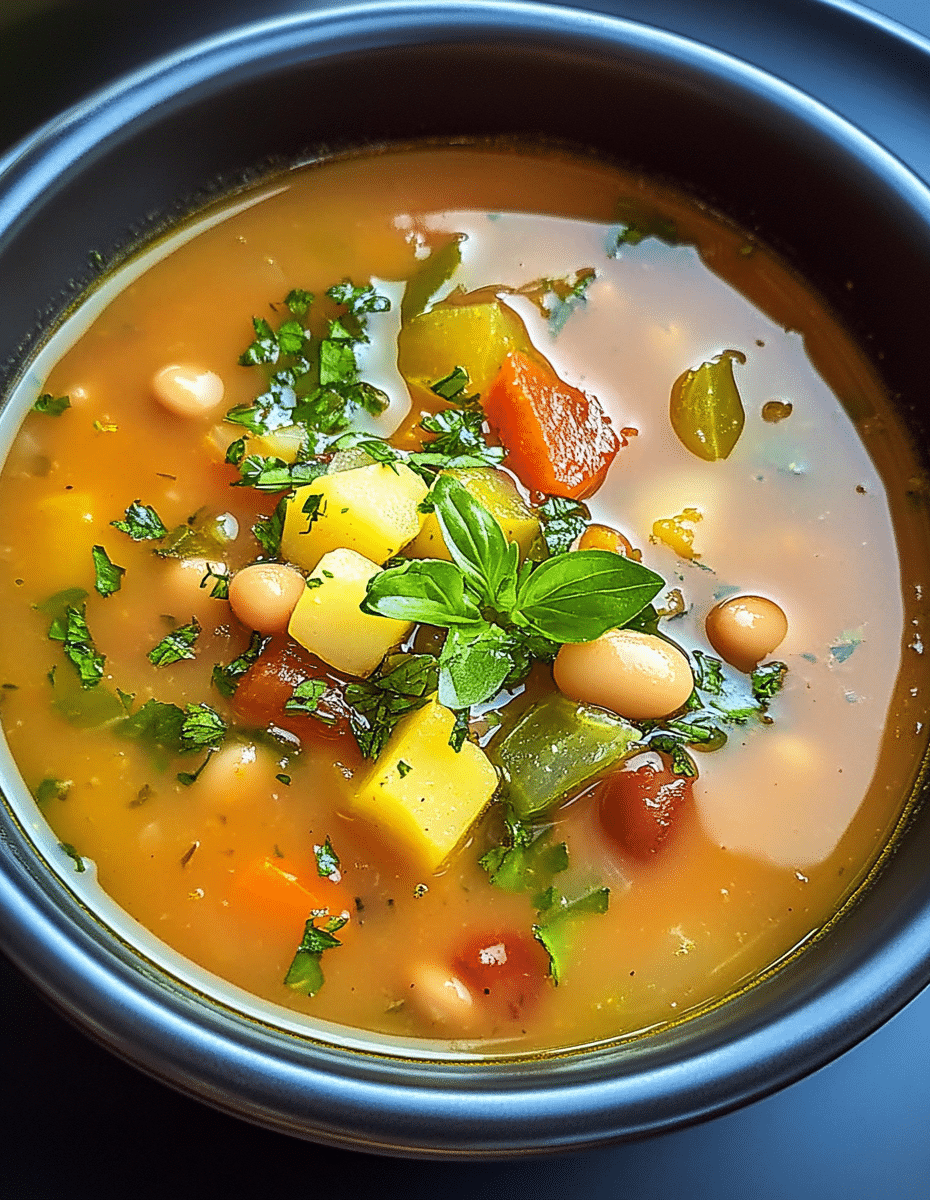Portuguese Bean Soup is a rustic, hearty dish that embodies the comforting spirit of Portuguese home cooking. Featuring tender white beans, smoky sausage, and aromatic vegetables simmered in a flavorful broth, this soup offers a rich and satisfying experience. Perfect for chilly days or whenever you need a nourishing, wholesome meal, it combines savory and earthy flavors that bring warmth to every spoonful.
Ingredients
-
2 cups dried white beans (such as navy or cannellini), soaked overnight
-
1/2 pound chorizo or smoked sausage, sliced
-
1 large onion, chopped
-
3 cloves garlic, minced
-
2 carrots, diced
-
2 celery stalks, diced
-
6 cups chicken or vegetable broth
-
1 bay leaf
-
1 teaspoon smoked paprika
-
Salt and freshly ground black pepper, to taste
-
2 tablespoons olive oil
-
Fresh parsley, chopped (for garnish)
Directions
-
Prepare the Beans: Drain and rinse the soaked beans. Set aside.
-
Cook the Sausage: In a large pot, heat olive oil over medium heat. Add the sliced sausage and cook until browned and fragrant. Remove sausage and set aside.
-
Sauté Vegetables: In the same pot, add onion, garlic, carrots, and celery. Cook for 5–7 minutes, or until softened.
-
Combine Ingredients: Add the soaked beans, browned sausage, broth, bay leaf, and smoked paprika. Stir well.
-
Simmer the Soup: Bring to a boil, then reduce heat to low. Cover and simmer for 1 to 1.5 hours, or until beans are tender. Stir occasionally, adding broth or water if needed.
-
Finish: Remove bay leaf. Season with salt and pepper to taste.
-
Serve: Ladle into bowls, garnish with chopped parsley, and enjoy with crusty bread if desired.
Nutritional Information (per serving, approx.):
-
Calories: 320 kcal
-
Total Fat: 14 g
-
Saturated Fat: 4 g
-
Cholesterol: 35 mg
-
Sodium: 750 mg
-
Total Carbohydrates: 30 g
-
Dietary Fiber: 9 g
-
Sugars: 4 g
-
Protein: 18 g
Flavor Profile and Cooking Techniques
The true charm of Portuguese Bean Soup lies in its layering of flavors and textures. The beans offer a creamy, earthy base that absorbs and enhances the tastes of the broth and spices. Smoked sausage—commonly chorizo or linguiça—adds bold, meaty notes with a subtle kick of heat and spice, depending on the variety used. Aromatics like onions and garlic infuse the broth with depth, while carrots and celery provide a gentle sweetness and balance.
The use of smoked paprika—a staple in Iberian cooking—imparts a warm, smoky undertone that distinguishes this soup from other bean-based dishes. The slow simmering process allows all these elements to meld beautifully, resulting in a bowl that’s as comforting as it is complex.
Traditional methods involve soaking dried beans overnight, which not only helps reduce cooking time but also enhances digestibility. While canned beans can be used for convenience, many purists insist on dried beans for their superior texture and ability to absorb flavor during long cooking times.
Variations Across Regions and Households
One of the most appealing aspects of Portuguese Bean Soup is its adaptability. Each family, region, or island community may have its own variation. Some include cabbage, kale, or collard greens to add bulk and nutrients, while others enrich the soup with potatoes or macaroni, creating a heartier meal. Some recipes call for tomato paste or diced tomatoes to create a slightly tangier broth, lending a subtle acidity that balances the richness of the sausage.
The sausage itself varies, too. Linguiça, a Portuguese-style cured pork sausage, is commonly used, but chorizo is often substituted, depending on availability. In regions like the Azores, where traditional cooking methods are still honored, you may find even more diverse renditions that incorporate local herbs and smoked meats.
In Hawaii, where Portuguese Bean Soup is served at festivals, school lunches, and family gatherings, it’s not uncommon to see recipes including elbow macaroni, ham hocks, or even cabbage, evolving the dish into a local favorite with a unique personality.
Nutritional and Health Considerations
Despite its hearty and indulgent flavors, Portuguese Bean Soup can be a balanced and nutritious meal. Beans are a nutritional powerhouse, offering high amounts of fiber, plant-based protein, and essential minerals such as iron, magnesium, and potassium. They help maintain digestive health, regulate blood sugar levels, and support cardiovascular function.
The vegetables in the soup—onions, garlic, carrots, and celery—provide antioxidants and phytonutrients that support overall wellness. Garlic, in particular, is known for its antimicrobial and anti-inflammatory properties.
While sausage adds depth and savory flavor, it also contributes fat and sodium. That said, you can moderate the richness of the dish by using leaner meats or plant-based sausage alternatives without sacrificing too much on flavor. Homemade or low-sodium broth is also a good choice to keep the salt content in check.
Ultimately, this soup offers an excellent balance of protein, fiber, and complex carbohydrates—making it a complete and satisfying meal, especially during colder months or when you’re in need of comfort food that still nourishes.
Serving Suggestions and Pairings
Portuguese Bean Soup is typically served hot and is often enjoyed with a slice of crusty bread or a hunk of rustic Portuguese broa (cornbread). The bread is perfect for soaking up the savory broth and adds an extra layer of comfort.
For a fuller meal, you can serve the soup alongside a fresh green salad or a simple cucumber and tomato salad with a vinegar-based dressing to add brightness and cut through the richness of the dish.
While this soup can stand on its own as a complete meal, it also makes a fantastic starter for a multi-course Portuguese-inspired dinner. Pair it with a glass of Vinho Verde or a light red wine such as a Pinot Noir to complement the smoky sausage and earthy beans.
If you’re meal prepping, Portuguese Bean Soup is a dream—it stores beautifully and tastes even better the next day, once the flavors have had more time to develop. It also freezes well, making it a convenient option for busy weeks.
The Comfort of Tradition
There’s something deeply comforting about a dish that connects you to history, family, and culture. Portuguese Bean Soup is not just a recipe—it’s a ritual. Whether passed down through generations or discovered anew in a home kitchen or local diner, the soup speaks of tradition, resilience, and the beauty of simple ingredients cooked with care.
For many, the act of preparing this soup—soaking the beans, browning the sausage, slowly building the flavors over time—becomes a meditative and rewarding process. It’s the kind of meal that invites you to slow down, savor, and share.
Conclusion
Portuguese Bean Soup embodies everything that makes traditional cuisine special: it’s resourceful, flavorful, and rich with history. A dish born from humble beginnings, it has transcended borders and adapted to new homes without losing its soul. Whether you’re enjoying a steaming bowl on a chilly winter evening or sharing it at a festive gathering, this soup offers warmth in every sense of the word.
Its hearty ingredients, adaptable nature, and nutritional benefits make it a standout dish worthy of a place in any kitchen. And as with many traditional recipes, the most important ingredient is the one you can’t write down: the love and care that goes into making it. Serve it to your family, pass it on to friends, and let it become a cherished part of your own culinary heritage.






